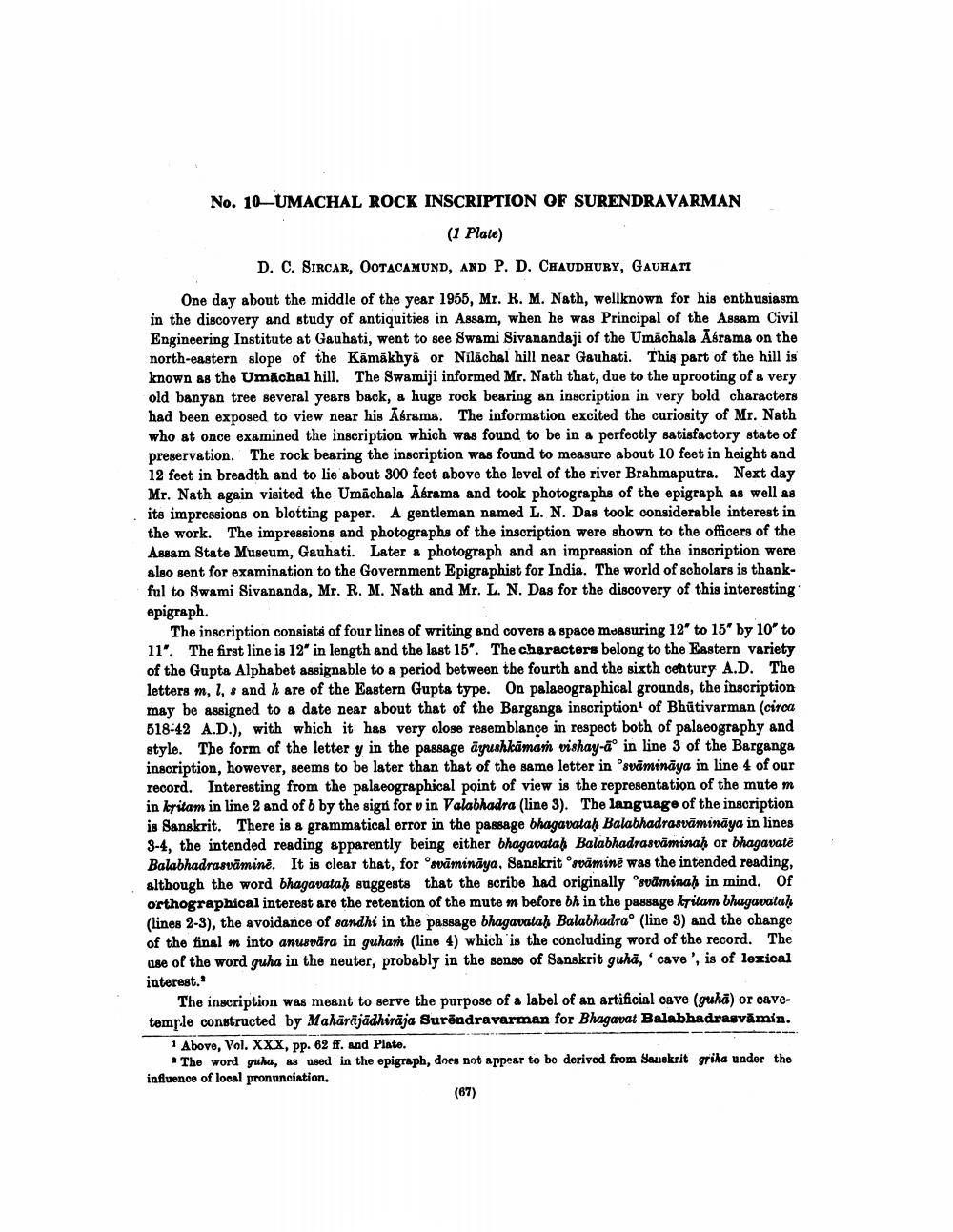________________
No. 10-UMACHAL ROCK INSCRIPTION OF SURENDRAVARMAN
(1 Plate)
D. C. SIRCAR, OOTACAMUND, AND P. D. CHAUDHURY, GAUHATI
One day about the middle of the year 1955, Mr. R. M. Nath, wellknown for his enthusiasm in the discovery and study of antiquities in Assam, when he was Principal of the Assam Civil Engineering Institute at Gauhati, went to see Swami Sivanandaji of the Umachala Asrama on the north-eastern slope of the Kamakhya or Nilachal hill near Gauhati. This part of the hill is known as the Umachal hill. The Swamiji informed Mr. Nath that, due to the uprooting of a very old banyan tree several years back, a huge rock bearing an inscription in very bold characters had been exposed to view near his Asrama. The information excited the curiosity of Mr. Nath who at once examined the inscription which was found to be in a perfectly satisfactory state of preservation. The rock bearing the inscription was found to measure about 10 feet in height and 12 feet in breadth and to lie about 300 feet above the level of the river Brahmaputra. Next day Mr. Nath again visited the Umachala Asrama and took photographs of the epigraph as well as its impressions on blotting paper. A gentleman named L. N. Das took considerable interest in the work. The impressions and photographs of the inscription were shown to the officers of the Assam State Museum, Gauhati. Later a photograph and an impression of the inscription were also sent for examination to the Government Epigraphist for India. The world of scholars is thankful to Swami Sivananda, Mr. R. M. Nath and Mr. L. N. Das for the discovery of this interesting epigraph.
The inscription consists of four lines of writing and covers a space measuring 12" to 15" by 10" to 11". The first line is 12" in length and the last 15". The characters belong to the Eastern variety of the Gupta Alphabet assignable to a period between the fourth and the sixth century A.D. The letters m, 1, 8 and h are of the Eastern Gupta type. On palaeographical grounds, the inscription may be assigned to a date near about that of the Barganga inscription1 of Bhutivarman (circa 518-42 A.D.), with which it has very close resemblance in respect both of palaeography and style. The form of the letter y in the passage ayushkāmaṁ vishay-a in line 3 of the Barganga inscription, however, seems to be later than that of the same letter in "svaminaya in line 4 of our record. Interesting from the palaeographical point of view is the representation of the mute m in kritam in line 2 and of b by the sign for v in Valabhadra (line 3). The language of the inscription is Sanskrit. There is a grammatical error in the passage bhagavataḥ Balabhadrasvamināya in lines 3-4, the intended reading apparently being either bhagavatah Balabhadrasvaminaḥ or bhagavate Balabhadrasvamine. It is clear that, for sväminäya, Sanskrit svamine was the intended reading, although the word bhagavataḥ suggests that the scribe had originally sväminah in mind. Of orthographical interest are the retention of the mute m before bh in the passage kritam bhagavataḥ (lines 2-3), the avoidance of sandhi in the passage bhagavatah Balabhadra (line 3) and the change of the final m into anusvära in guham (line 4) which is the concluding word of the record. The use of the word guha in the neuter, probably in the sense of Sanskrit guha, cave', is of lexical interest."
The inscription was meant to serve the purpose of a label of an artificial cave (guha) or cavetemple constructed by Mahārājādhiraja Surendravarman for Bhagavat Balabhadrasvamin.
1 Above, Vol. XXX, pp. 62 ff. and Plate.
The word guha, as used in the epigraph, does not appear to be derived from Sanskrit grika under the influence of local pronunciation.
(67)




